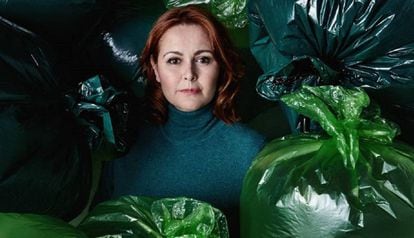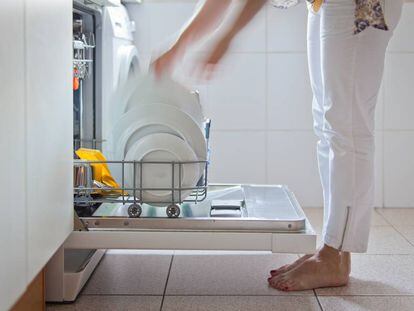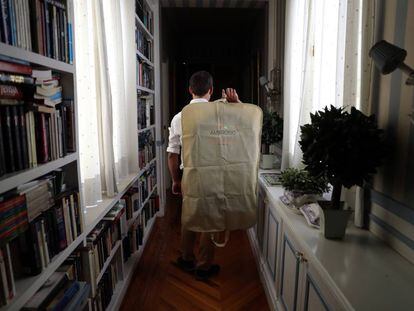The Marie Kondo revolution hits Spain
In an increasingly chaotic world, the advice of the Japanese organizing guru promises to bring happiness. She has thousands of followers, and her method is not only a lifestyle choice, it is also big business

“I’m sorry. Seeing disorganized things upsets me,” says Alicia Iglesias as she lines 12 plastic chairs up to the last millimeter around a wooden table. She is about to teach a workshop on tidiness in a co-working space in Madrid which will be attended mostly by women in search of tips on creating harmony in the home and in their lives in general. Today 15 people have paid €40 each for a three-hour session of 21 days to get your house in order.
“Organization is like doing sport or being on a diet,” says Alicia, 35. “You have to find the right moment to start.”
For her, that moment came when she moved from Asturias to Madrid to study biology and shared an apartment with other students. The place was a total mess. “I realized I couldn’t live like that,” she says. “I started to sort out my roommates’ rooms.”
Years later, after being made redundant from her job as a consultant, she decided to turn her love of throwing things out into a job. In 2006 she started the first organization blog in Spain and now has a client base of around 100 from exclusive neighborhoods of Madrid such as Salamanca, Somosaguas and La Finca estate. “I can’t reveal names, but I can tell you that one of them has an Oscar in their cupboard,” she confides.
According to fellow organizer Cloti Martínez from Catalonia, who specializes in wardrobes, Marie Kondo is partly responsible for the organization fad in Spain, but the fact that our lives have become increasingly frantic has also contributed. “We live in a society where we are bombarded by information and there is a lot that escapes our attention. In response, we try to control our environment in a bid to take control of our lives,” she says.
Alicia and Cloti are part of a professional movement that only really took off in 2015 when Marie Kondo mania swept across Europe and the US. The phenomenon started in Japan four years earlier when Kondo published The Life-Changing Magic of Tidying Up, a book that advised us to get rid of all the things in our lives that were making us unhappy.
That same year, the author and philosopher Keisuke Matsumoto wrote A Buddhist Monk’s Guide to Housecleaning, which railed against excess and materialism and spoke of the spiritual teachings he received in a Buddhist temple, applied to daily life in 21st-century Japan. Both books, with their message of personal growth and order in our material lives, were a runaway success. In fact, the idea that order in the home is the first step towards happiness is nothing new in the Western world. It has simply been repackaged and presented afresh with a minimalist oriental perspective that is powerfully attractive.
Spain now has an Association of Professional Organizers (AOPE), which was established in 2016. But while a similar outfit in the US has 4,000 members, Spain has only managed to group together 120 members, the vast majority of whom are women. It seems that many professional organizers here, like Alicia, prefer to steer their own course.
Their fees range from €35 and €60 an hour. Sorting a wardrobe generally takes them two hours while kitchens, living rooms and storage rooms can take four. Alongside teenagers’ and children’s bedrooms, these are the most common spaces they are called upon to unclutter. “I am not a super nanny,” says Alicia. “I don’t argue with anyone, nor am I going to tell off untidy children. That’s the parents’ job.”
Among those most likely clients to call for help are families with a tendency for accumulating junk, recently divorced couples and longstanding singles. “The hardest calls, which almost always make me cry, are the ones asking you to empty the house of someone who has died,” says Alicia. “The children get us in there because it’s too emotionally hard for them, or because they can’t agree among themselves.”
The Japanese take on organization changed Vanesa Travieso’s life. She left her “super well-paid job” marketing medical products to Latin America, Spain and Portugal because it meant spending long periods away from her family, and then, almost by coincidence, came across Marie Kondo’s book. “I’ve never read a book that fast,” says Vanesa, 44, who now travels between Barcelona and Madrid as a professional organizer. “I finished it in a day and a half. From the start, I totally identified with her.”
The following week she got in touch with the Japanese team and was selected to attend a workshop run by Kondo herself in Chicago. She paid €2,000 for the three-day course where she learned the art of folding vertically and lining clothes up like books on a book shelf, a Kondo trademark. “I realized that there were many things and people around me that I no longer wanted,” she says, explaining a deeper aspect of what she learned. “I had them around me because of a sense of commitment or because of what people would say. When I returned to Barcelona, the first thing I did was to end two toxic friendships.”
The psychologist Eparquio Delgado believes that Kondo’s ‘happiness through organization’ message has a placebo effect. “Happiness is a word that can be applied to anything because it means nothing,” he says.
However, as far as these professionals are concerned, emptying our lives of chaos is usually the start of profound change. “I had a client once who called me to organize her office and she ended up leaving her job as a mathematician,” says Cloti Martínez, who believes that being disorganized typically reflects inner confusion. “Many people decide to tackle the outside before daring to tackle a deeper problem.”
A certain number of clients are men who resort to organizers during divorce to ease their departure from the family home. In these circumstances, the Argentinian organizer María Gallay, 50, offers her services as a personal shopper. “I take them shopping to get the bare minimum. Some of them even prefer for me to go alone to Ikea for the basics,” she says.
On the down side, an excessive need to tidy up can be a sign of obsessive compulsive disorder (OCD) or even its counterpart, Diogenes syndrome. María Gallay has a vivid memory of a diplomat who had hemmed himself into his home in Madrid with hundreds of books and old newspapers. “The whole house, except for the bed, was filled with piles of things from floor to ceiling,” she says. She worked with him for three months to produce a semblance of order. The process was so traumatic that she had to undergo therapy herself “in order to have the necessary self-control and patience for the job”. But sometimes the problem swings the other way. She was also called in by a psychiatrist to help a designer with OCD to empty her apartment before moving to Copenhagen. “We wiped off every speck of dust from her books before putting them in boxes,” she says. “It was a very difficult job.”
Kondo also had a cathartic effect on the life of former banker Mar Ferré, 45, who left Catalunya Caixa when the lender implemented a collective layoff plan at the start of 2016. “I started to put up signs around Barcelona asking: ‘Do you want me to help you get organized?’” Once she had her first clients she realized that our emotions are revealed through objects and she coined the phrase order therapy. “My goal is not to turn your house into something out of Pinterest, but to help you get in touch with yourself through orderliness; it’s a wonderful tool for managing your emotions and adapting to change,” she says.
Central to her therapy is tackling attachments. The flow box is, she says, “an empty space we need to create mentally to allow new things to come into our lives.” But first, you have to let the attachment to objects go. “This is what is hardest for us because they reflect past fears and, above all, a great fear of the future. Our grandparents and parents lived through a war and a post-war era. They keep everything just in case. That habit has been exacerbated by consumerism and a philosophy of throwing out rather than fixing.”
But not all professional organizers draw their inspiration from Marie Kondo. Some say their techniques come from a much earlier period. “I don’t subscribe to her method at all,” says Alicia Iglesias. “Vertical folding was invented a zillion centuries ago.”
Pepa Tabero is another professional declutterer who wishes to distance herself from oriental minimalism. On her many YouTube videos, she introduces her 40,000 subscribers to simple domestic tricks such as how to clean an upholstered chair, get white clothes back to their original state or take vomit stains out of babywear. Perhaps because of her military background (she was the first woman to work on a Navy ship, where she spent three years making nautical charts), she rejects any Japanese influence. “Zen is too ethereal,” she says. “We Spanish are very baroque and very different from the Japanese. If there is one thing you learn in the military, it is how to lead a life in which order is a priority. I applied this to my home and it worked. Now I try to do the same with the homes of my clients,” she says in a martial tone.
The procedure changes according to the professional. But in general the first step is a chat or an exchange of emails, which leads to a visit to the place where chaos reigns. “I ask a lot of questions to establish the client’s needs and what I am going to come up against,” says Cloti. “Once I am in the house, I usually prefer for the owner to be present and I offer a diagnosis following a brief inspection. As photos are usually sent through beforehand, you go in with a pretty clear idea, although sometimes once you are there, you realize the problem actually lies elsewhere.”
But what happens after the professionals have gone home? To avoid clients falling back into bad habits, Pepa Tabero posts small reminders around their house, such as ‘Make your bed’, or ‘Clean the kitchen’. “You have to have routines,” she says. “And these routines have to be respected.”
It almost goes without saying that perfectionism is the hallmark of these professionals, and it is often taken to extremes. “There are a lot of control freaks in our line of work,” says Cloti. “A lot of us will not like it if someone moves a glass two centimeters from where we placed it.”
Vanesa Travieso also admits that she walks a fine line between being a tidy person and a maniac. “I have spent months trying to leave the house without making my bed, telling myself that it doesn’t matter,” she says. Finally, she feels she is making progress.
English version by Heather Galloway.


